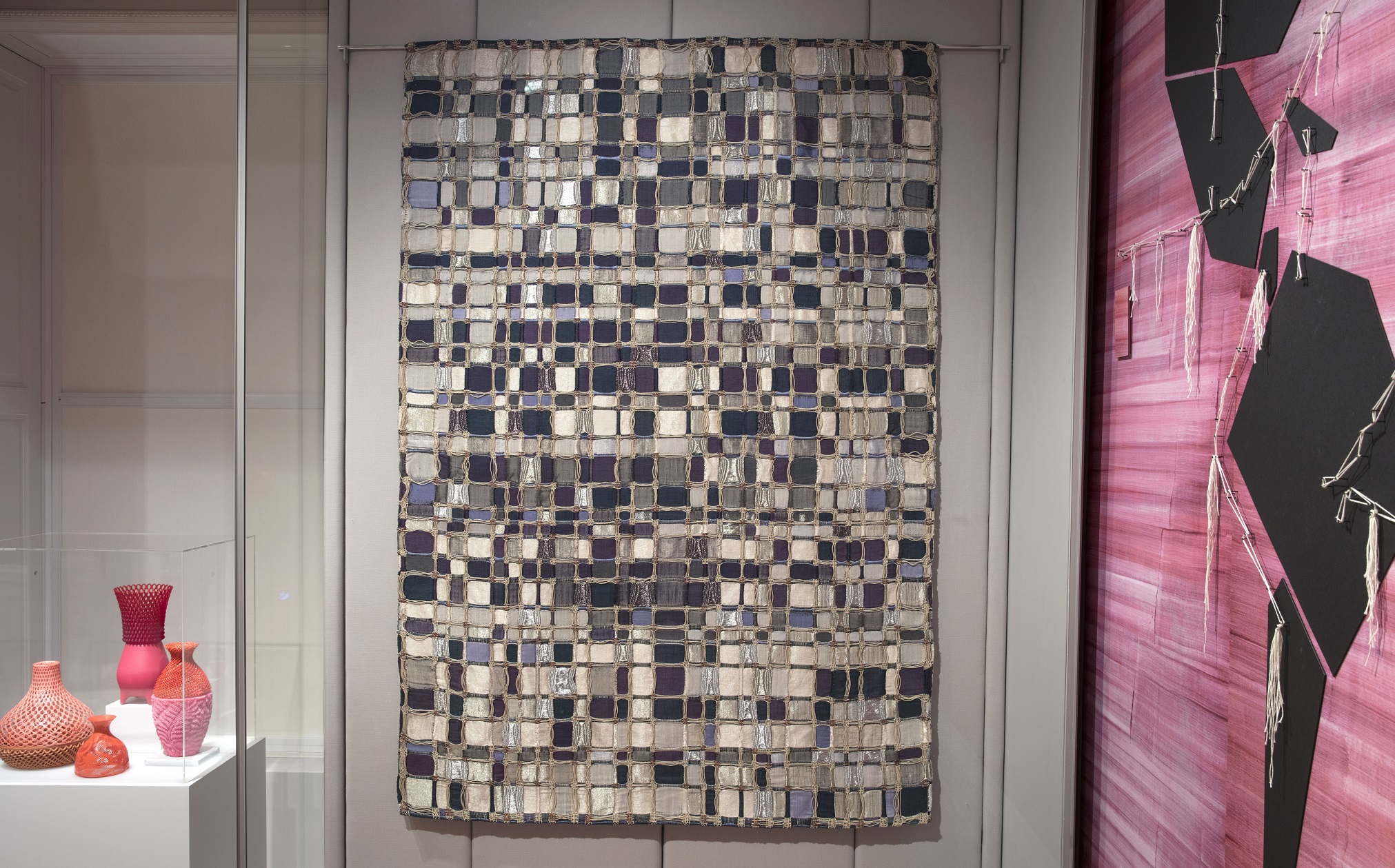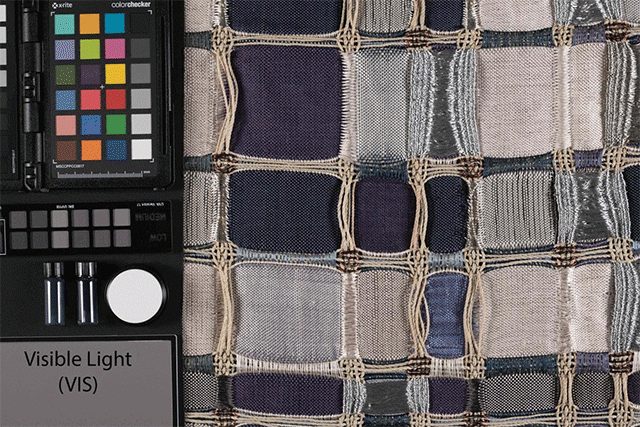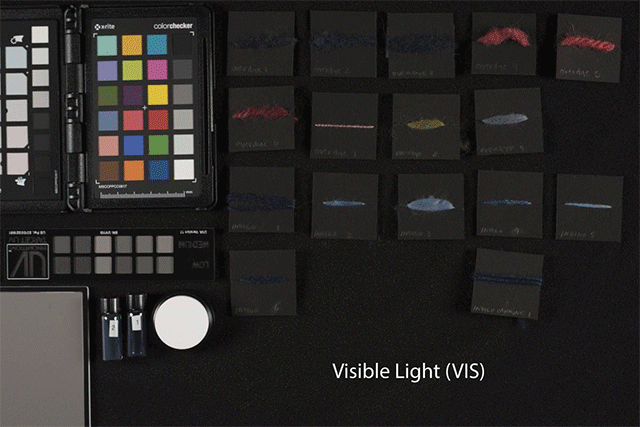
Nebula designed by Eduardo Portillo (Venezuelan, b. 1966) and made by María Dávila, (Venezuelan, b. 1966), exhibited in Nature by Design: Cochineal. Photo: Matt Flynn © Smithsonian Institution.
by Jessica Walthew (objects conservator), Kira Eng-Wilmot (textile conservator), and Pauline Nguyen (conservation intern)
Nebula by Eduardo Portillo and María Dávila is made with a beautiful variety of fibers and dyes, including indigo in different intensities and in combination with the red dye cochineal to yield a dark purple color. This woven textile features an arrangement of 972 mosaic squares in different shades of blue, purple, and white, with metallic and natural palm fiber elements. The complex woven structure is a triple weave with two warps of silk and palm fiber, and makes use of a variety of fibers and dyes: silk, wool, moriche palm fiber, copper, metallic yarn; dyed with indigo, cochineal, eucalyptus, onion, and lengua de vaca (Rumex spp.). These natural dyes have a long history of use throughout the Americas, with indigo dye identified on archaeological textiles in Peru from as early as 7,800 years ago (Splitstoser et al. 2016) and still used on your denim jeans today.
We were excited to use this piece as a test case for a new imaging technique we had never tried before. Previously described by the Museum Conservation Institute (MCI) and Brooklyn Museum, Multiband Reflectance Imaging Subtraction (MBRIS) involves using special bandpass camera filters (which cut off light above or below a certain boundary, e.g. at 660 and 735 nm of light) to take two images and combine them, “subtracting” one from the other (Webb et al 2014, Kriss et al. 2019). While several blue pigments (including smalt, ultramarine, cobalt, and cerulean) have similar reflectance qualities, for this textile we knew we were looking to identify indigo used as a dye. Dyes such as cochineal and indigo respond to different light energies in unique ways. Owing to indigo’s unique reflectance characteristics (a strong absorbance around 660 nm and a high reflectance just under 800 nm, Leona and Winter 2001), the “subtracted” image gives a distribution map of indigo, with indigo-dyed areas appearing white in the MBRIS image. In another type of manipulated photo we generate by combining images from our Multiband imaging set, the infrared reflected false color image (IRRFC), indigo typically appears red (Kriss 2018).

Animated GIF showing a detail from Nebula in visible light, in computationally manipulated images Multiband Reflectance Subtraction (in which indigo shows up white), and Infrared Reflected False color (in which indigo shows up red).
As you can see by comparing the three images, Nebula’s response to these special illumination and capture conditions was consistent with the documented use of indigo as the primary dye represented throughout the textile. We also tested this technique on known reference samples of indigo overdyed with cochineal and other colorants and observed similar responses.

GIF showing reference samples of wool with indigo and other dyes used in combination, imaged with different techniques. Samples 1–3 (top row) are cochineal overdyed with indigo; samples 4–7 (first and second rows) are indigo overdyed with cochineal. The red response in IRRFC and white response in IRR is consistent in the object and the cochineal with indigo overdye samples
We are excited to add this interesting imaging technique to our toolbox: we plan to image works on paper and other objects in the collection to see what more we can learn with this non-destructive way to characterize artist’s materials.
Acknowledgements: Cooper Hewitt’s imaging suite was purchased with funds granted from the Smithsonian Research Equipment Pool. Our special thanks to Dawn Kriss and Anna Serotta for training and advice, and Pauline Nguyen for her work carrying out the imaging during her 2019 Krueger summer internship in conservation.
References:
Kriss, Dawn, Elyse Driscoll, Jessica Ford, Lauren Bradley, and Victoria Schussler. (2019) “Materials characterization with Multiband Reflectance Image Subtraction at the Brooklyn Museum: a New Tool for the Multiband Imaging Kit.” American Institute for Conservation 47th Annual Meeting, May 16, 2019. https://aics47thannualmeeting2019.sched.com/event/Iui6/imaging-toolstechniques-tactics-materials-characterization-with-multiband-reflectance-image-subtraction-at-the-brooklyn-museum-a-new-tool-for-the-multiband-imaging-kit
See also, a series of Brooklyn Museum Blogposts by their conservation team on Multiband Reflectance Subtraction Imaging:
- Dawn Kriss on Maya Blue on a terracotta sculpted figure
- Elyse Driscoll on a Japanese woodblock print
- Dawn Kriss and Sarah Levin on an Egyptian foot case
- Victoria Schussler on a Lapis lazuli clock
Leona, Marco, and John Winter. (2001) Fiber Optics Reflectance Spectroscopy: A Unique Tool for the Investigation of Japanese Paintings Studies in Conservation Vol. 46, No. 3 (2001), pp. 153-162.
Splitstoser, J., Tom Dillehay, Jan Wouters, and Ana Claro. (2016) Early pre-Hispanic use of indigo blue in Peru. Science Advances, Vol 2, no. 9. 14 Sep 2016. https://advances.sciencemag.org/content/2/9/e1501623
Webb, E. Keats, Rebecca Summerour, and Jennifer Giacchi. (2014) ”A Case Study using Multiband and Hyperspectral Imaging for the Identification and Characterization of Materials on Archaeological Andean Painted Textiles” AIC Textile Specialty Group Postprints Volume 24: 23-35.